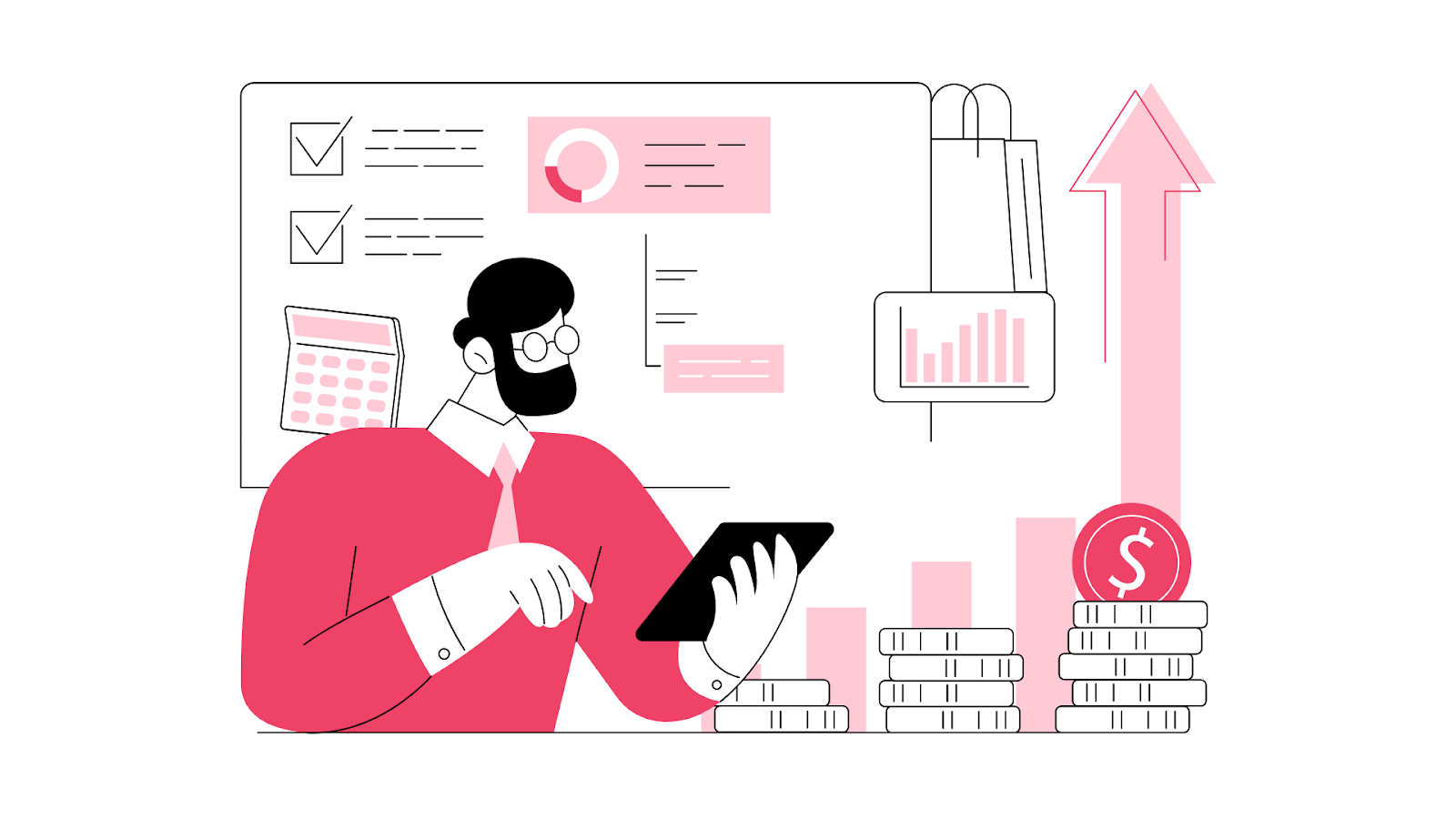AI in Predictive Sales Forecasting: Shaping the Future of Sales
Learn how AI in predictive sales forecasting boosts accuracy, enhances decision-making, and helps optimize resources for business growth.

What if you could predict your sales with greater accuracy and make smarter decisions ahead of time? Sales forecasting is crucial for business success, but with AI in predictive sales forecasting, you can take it to the next level. AI analyzes data in real-time, helping you adapt quickly to market changes and improve resource allocation. According to McKinsey, AI-driven forecasting can reduce forecasting errors by 20% to 50%. This level of accuracy empowers sales teams to make proactive, data-backed decisions—improving inventory planning, aligning staffing needs, and driving strategic growth with greater confidence.
In this blog, we'll explore why sales forecasting matters, how AI is transforming it, and the key benefits for your business. Ready to unlock the future of sales forecasting? Let’s dive in!
Why is Sales Forecasting Important?
Sales forecasting is crucial for the success and growth of your business. By predicting future sales trends, you can better allocate resources, manage cash flow, and make informed decisions about marketing and inventory.
A report by Gong reveals that over 80% of companies have missed their sales forecasts in at least one quarter over the last two years. This statistic underscores the challenges businesses face in accurately predicting revenue.
Sales forecasting is important for your business in many ways. It helps you plan ahead and make better decisions. Here’s why it matters:
1. Better Budgeting and Financial Planning: Accurate sales forecasts help you manage your budget effectively, predict cash flow, and make smarter investment decisions.
2. Improved Inventory Management: Forecasting helps you avoid overstocking or understocking, ensuring you have the right products available at the right time.
3. Efficient Resource Allocation: With sales forecasts, you can allocate staff, marketing efforts, and production resources based on expected demand, ensuring you’re prepared for changes.
4. Guides Strategic Planning: Sales forecasts provide insights into future trends, helping you plan long-term strategies, like expanding into new markets or launching new products.
5. Measures Performance and Adjusts Strategy: Forecasts give you a benchmark to compare actual sales, helping you track performance and make adjustments if needed to stay on target.
As you look for ways to enhance your sales forecasting, one of the most effective solutions today is AI, which offers real-time insights and helps you make more precise predictions.
How is AI Valuable in Sales Forecasting?
AI can greatly improve your sales forecasting by providing more accurate and actionable insights. Using machine learning, AI analyzes past sales data to find patterns and adjust predictions in real time. This helps you stay aligned with current trends and anticipate changes in demand or market conditions. By pulling data from different sources like CRM systems and customer behavior, AI gives you a clearer, more complete picture of your market.
AI also saves you time by automating the process of data analysis, letting you focus on strategy. It can simulate different scenarios, helping you plan for potential risks or opportunities. With real-time updates, AI ensures that your forecasts remain relevant and responsive to market changes. Additionally, it can spot unusual sales trends early, so you can act quickly. Ultimately, AI helps you make smarter, data-driven decisions that improve your sales strategies and resource planning.
AI brings significant benefits to predictive sales forecasting. Let’s dive deeper into these advantages.
What are the Benefits of Using AI in Predictive Sales Forecasting?
Using AI in predictive sales forecasting offers several key benefits that can enhance your sales strategy and decision-making. Here are the main advantages:
- Enhanced Forecast Accuracy: AI enables you to make more precise sales predictions by analyzing historical data and current pipeline trends, reducing guesswork and increasing reliability in your decision-making.
- Real-Time Adaptability: AI adjusts forecasts dynamically as deals evolve, providing you with up-to-the-minute insights that help you react quickly to changes in the pipeline and stay ahead of potential issues.
- Smarter Lead Prioritization: By scoring leads based on their likelihood to close, AI helps you focus your resources on the most promising opportunities, maximizing your conversion rates and boosting sales productivity.
- Proactive Bottleneck Detection: AI identifies pipeline bottlenecks early, allowing you to address obstacles before they delay deals, keeping your sales process efficient and your revenue flow steady.
- Optimal Resource Allocation: With AI’s insights, you can allocate your sales team’s time and energy more effectively, ensuring that the highest-value opportunities get the attention they deserve, driving better results.
By Using AI in predictive sales forecasting, you gain the ability to make more informed, proactive decisions, improve sales outcomes, and increase operational efficiency.
To truly capitalize on the power of AI in sales forecasting, it's essential to move beyond the technology itself and focus on how it's applied. That’s where strategy comes in.
7 Strategies for Effective AI Sales Forecasting
To unlock the full power of AI in predictive forecasting, businesses must apply structured, data-driven strategies. Here are seven proven methods drawn from industry leaders:
- Utilize Multiple Forecasting ModelsAI doesn’t rely on one-size-fits-all. From time series analysis to regression and ensemble learning, combining methods improves accuracy by accounting for different variables and data complexities.
- Continuously Train and Refine ModelsSales patterns shift due to market conditions, buyer behavior, or economic changes. AI models should be retrained regularly using up-to-date data to stay relevant and accurate.
- Focus on Data Quality and VolumeClean, structured, and abundant data is critical. Incomplete or siloed data weakens AI output. Centralizing and standardizing datasets ensures consistency across forecasting efforts.
- Incorporate External and Unstructured DataGo beyond internal metrics. AI can analyze third-party sources—like economic indicators, weather, or social sentiment—to surface hidden influences on sales performance.
- Embed AI into Sales WorkflowsForecasting should be actionable. Embed AI tools directly into CRM systems and sales dashboards to drive immediate insights and guide rep behavior in real time.
- Segment Customers with Clustering TechniquesAI can group customers by purchasing behavior or preferences using clustering. This enhances personalization and helps refine forecast accuracy per segment.
- Encourage Human-AI CollaborationAI enhances—not replaces—human judgment. Sales leaders should collaborate with data teams to validate insights, provide feedback, and align models with business goals.
After learning about the strategies. Now, let’s look at how you can incorporate AI into your sales forecasting strategy and start seeing immediate results.
How to implement AI in your Startup’s Sales Forecasting Strategy
Implementing AI in your sales forecasting strategy can be a game-changer. Here’s a step-by-step guide on how to integrate it effectively:
Step 1: Define Objectives and Gather Data
Start by defining clear goals for AI in sales forecasting, such as improving accuracy or predicting trends. Next, collect and clean data, including historical sales, customer interactions, and market trends. Clean, accurate data is crucial for reliable AI predictions.
Step 2: Choose and Train AI Tools
Select AI tools that integrate with your existing CRM or ERP systems. Popular options include Salesforce Einstein, HubSpot, and Microsoft Dynamics 365. Train the AI model using your data, allowing it to identify patterns and trends to improve the accuracy of forecasts.
Step 3: Integrate AI into Sales Process
Embed AI insights directly into your CRM or sales dashboard so your team can use forecasts and recommendations in their daily activities. Ensure the sales team understands how to interpret and act on these insights to guide their strategies.
Step 4: Monitor, Optimize, and Train
Regularly monitor AI performance and adjust as needed. Continuously feed fresh data into the system to enhance accuracy. Keep optimizing the model and provide ongoing training for your sales team to maximize the benefits of AI.
By following these steps, you can successfully integrate AI into your sales forecasting strategy, giving you more accurate insights and enabling better decision-making.
Supercharge Your Sales Strategy with AI-Powered Solutions from Alisha
Sales forecasting is crucial for your business success, and with AI in predictive sales forecasting, you can enhance accuracy, gain real-time insights, and make smarter decisions. AI helps you stay agile, adapt to market trends, and optimize your resources effectively. By using AI, you can prioritize the right opportunities and drive better outcomes for your business. The future of sales forecasting is here, and AI gives you the edge to stay ahead.
Ready to take your sales development to the next level? Alisha can transform your outbound sales efforts by automating prospecting, personalized outreach, and scheduling, all while boosting productivity. Don’t let manual tasks slow you down—let Alisha handle the heavy lifting so you can focus on what truly matters: closing deals and growing your business. Contact us now!
FAQs
1. How is AI used in sales forecasting?
AI analyzes historical data, identifies patterns, and forecasts future sales more accurately. This reduces reliance on guesswork, helping companies optimize inventory levels, streamline supply chains, and meet customer demand more efficiently.
2. How can AI be used in forecasting?
AI improves forecasting by analyzing large datasets and learning from patterns over time. It can predict seasonal trends, customer behavior shifts, and external factors like market conditions, enabling businesses to plan more effectively for future demand.
3. Which method is used to predict future sales?
Standard AI-driven methods for sales prediction include time-series forecasting, regression models, and machine-learning algorithms. These techniques analyze past sales data and external variables to generate more accurate forecasts than traditional methods.
4. How does AI predict the stock market?
AI uses advanced algorithms to analyze real-time market data, financial reports, and news and social media sentiment. Some AI systems have been able to predict market trends with greater accuracy than traditional models, offering valuable insights for investors.
5. Will AI replace salespeople?
AI will not fully replace salespeople but will support them by automating repetitive tasks such as data entry, lead scoring, and customer outreach. This will let sales teams to focus on high-value tasks like relationship building and negotiations.


